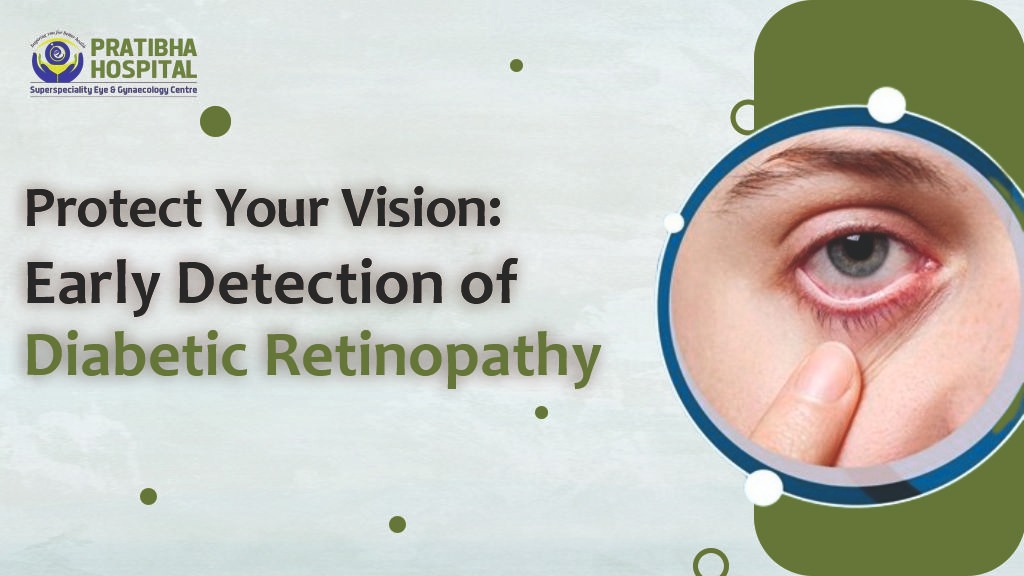Diabetic Retinopathy Treatment: Signs, Care, and Management for Healthy Vision
What is Diabetic Retinopathy?
Diabetic retinopathy is a diabetes-related eye disease where high blood sugar damages the retina’s blood vessels, causing them to swell and leak or block, which can lead to blurry vision and blindness.
When blood sugar stays high for many years, these vessels can swell, leak, or get blocked. In later stages, new fragile vessels may grow inside the eye. These are weak and may bleed, which can cause serious vision problems.
It is also called a diabetic eye disease. The problem is that in the early stage you may not notice any symptoms. But if not treated, it can slowly lead to vision loss and even blindness. This is why regular eye checkups are very important for anyone living with diabetes.
Stages of Diabetic Retinopathy
Doctors usually describe three stages of this disease:
1. Non-Proliferative Diabetic Retinopathy (NPDR)
This is the most advanced stage. New, fragile blood vessels developed on the surface of the retina because of poor oxygen supply.
These vessels are weak and may bleed inside the eye. If bleeding is heavy, it can block vision. Scar tissue may also pull the retina, leading to detachment.
2. Proliferative Diabetic Retinopathy (PDR)
This is more serious. Because the retina is not getting enough oxygen, it tries to grow new blood vessels. These vessels are weak and can break easily, causing bleeding inside the eye. If bleeding is heavy, vision may suddenly go dark. Scar tissue may also form, which can pull the retina and cause retinal detachment.
3. Diabetic Macular Edema (DME)
The macula is the center of the retina that gives sharp, clear vision. In DME, fluid collects here, causing swelling. People with DME often find it hard to read, drive, or recognize faces.
Signs and Symptoms of Diabetic Retinopathy
Many people with diabetic retinopathy do not notice symptoms in the beginning. As the disease gets worse, you may see:
- Blurred or cloudy vision
- Dark spots or floaters in vision
- Difficulty seeing at night
- Blood behind the eye, making vision hazy or red
- Colors looking faded
- Sudden vision loss in one or both eyes
If you have diabetes and face any of these, consult an eye doctor or retina specialist quickly.
Causes and Risk Factors
The main reason for diabetic retinopathy is high blood sugar over time. But other things can make it worse:
- Uncontrolled diabetes – The higher and longer your sugar levels stay, the greater the risk.
- High blood pressure and cholesterol – These damage blood vessels faster.
- Duration of diabetes – If you’ve had diabetes for over 10 years, the chance of retinopathy is higher.
- Kidney problems – Often linked with more severe cases.
- Smoking – Cuts oxygen supply to the retina.
- Pregnancy in diabetic women – May speed up progression.
How is Diabetic Retinopathy Diagnosed?
Eye doctors use different tests to find diabetic retinopathy:
- Dilated eye exam – Drops are used to widen pupils so the retina can be checked.
- Fundus photography – Clicks detailed images of the back of the eye.
- Optical Coherence Tomography (OCT) – Creates cross-section images of the retina to show swelling or fluid.
- Fundus Fluorescein Angiography (FFA) – A special dye highlights leaking or blocked vessels.
- Visual acuity and eye pressure tests – To check overall eye health.
These tests help decide which treatment or management option is needed.
Diabetic Retinopathy Treatment Options
The aim of treatment is to stop or slow down the disease and protect vision. The choice depends on how advanced the retinopathy is.
1. Lifestyle and Medical Management
- Keep blood sugar under control (HbA1c under 7% is usually recommended).
- Manage blood pressure and cholesterol.
- Quit smoking and follow a healthy lifestyle.
- Get regular diabetic eye checkups.
2. Laser Treatment (Photocoagulation)
In this method, a laser is used to seal leaking vessels and prevent new abnormal growth. Laser treatment cannot restore lost vision, but it helps stop further damage.
3. Anti-VEGF Injections
Medicines like Ranibizumab (Lucentis), Bevacizumab (Avastin), and Aflibercept (Eylea) are injected into the eye. They block VEGF, a substance that causes abnormal vessel growth. This treatment works well for diabetic macular edema.
4. Vitrectomy Surgery
In advanced cases where there is heavy bleeding inside the eye or retinal detachment, doctors may perform vitrectomy surgery. The gel inside the eye (vitreous) is removed along with blood and scar tissue. The space is then filled with a clear fluid.
Often, doctors combine these treatments depending on the stage of the disease.
Can Diabetic Retinopathy Be Prevented?
Yes, in many cases it can be delayed or prevented with good care. Simple steps include:
- Keep sugar, blood pressure, and cholesterol under control.
- Go for an eye checkup at least once a year.
- Do not smoke.
- Eat a balanced diet with fruits, vegetables, and whole grains.
- Exercise regularly.
- Share your full diabetes history with your eye doctor.
Key Insights & Data on Diabetic Retinopathy
- According to WHO, diabetic retinopathy is one of the leading causes of blindness among working-age adults.
- In India, the ICMR-INDIAB study (2021) found that nearly 1 in 5 diabetic patients show signs of retinopathy.
- The American Diabetes Association (ADA) states that good blood sugar control can reduce the risk of diabetic eye disease by up to 76%.
- More than 90% of vision loss cases from diabetic retinopathy are preventable if diagnosed and treated early.
Conclusion
Diabetic retinopathy is a serious but manageable condition. The key is early detection and regular care. If you have diabetes, never ignore changes in your vision. Visit an eye doctor once a year, or sooner if you notice symptoms. With proper treatment and lifestyle care, many people can protect their eyesight and live without fear of blindness.







